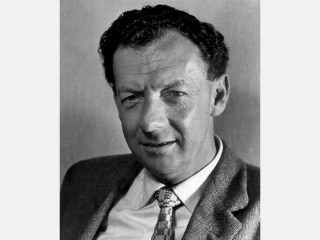
Benjamin Britten biography
Date of birth : 1913-11-22
Date of death : 1976-12-04
Birthplace : Lowestoft, Suffolk
Nationality : British
Category : Famous Figures
Last modified : 2011-01-06
Credited as : Composer and pianist, ,
The English composer, pianist, and conductor Benjamin Britten revitalized English opera after 1945.
Born in Lowestoft, Suffolk, Benjamin Britten had a normal preparatory school education, at the same time studying with some of the best musicians in England. At the age of 16 he entered the Royal College of Music on a scholarship. By then he had already composed a large quantity of music, and before long he was represented in print with the publication of the Sinfonietta for chamber orchestra, written when he was 19.
Prior to World War II Britten furnished music for a number of plays and documentary films. He also continued with other composing, the most prominent item being the Variations on a Theme by Frank Bridge (1937), his first major success. He lived in the United States from 1939 to 1942. Despite the turmoil of war, the period from 1939 to 1945 was a highly creative one for him, climaxed by the production of his opera Peter Grimes (1945). A year later Britten helped to form the English Opera Company, devoted to the production of chamber opera and in 1948 he founded the summer festival at Aldeburgh, where he made his home. He performed frequently in public as pianist and conductor.
Britten's performance skills were impressive, but even more so were the amount and variety of music he composed. Early in his career he wrote a moderate amount of solo and ensemble music for instruments, among which is The Young Person's Guide to the Orchestra (1946), comprising variations and fugue on a theme by Henry Purcell, and later he composed several big works for the cello. Quite in the British tradition, though, music employing voices far outweighs the purely instrumental in his output. He wrote over 100 songs, mainly organized in the form of song cycles or solo cantatas, which he called "canticles," and he made arrangements of several volumes of folk songs. Representative examples are the excellent Serenade for tenor, horn, and strings (1943); Canticle No. 3, Still Falls the Rain (1954); and The Poet's Echo (1967), six songs to poems of Aleksandr Pushkin. Complementing the solo pieces for voice are numerous large works involving chorus, such as A Ceremony of Carols (1942), the Spring Symphony (1949), the Cantata Academica (1960), and especially the War Requiem (1962), which are among his best and most popular compositions.
But it is his operas that carried Britten's name farthest. Beginning rather poorly with Paul Bunyan (1941), he made a spectacular turnabout with Peter Grimes. Following these operas came two chamber operas, The Rape of Lucretia (1946) and Albert Herring (1947); a new version of The Beggar's Opera (1948); Let's Make an Opera (1949), a work for children; Billy Budd (1951); Gloriana (1953), written for the coronation of Queen Elizabeth II; The Turn of the Screw (1954); A Midsummer Night's Dream (1960); and three dramatized parables for church performance. While by no means uniformly successful, they represent the most sustained and influential attempt by an Englishman to create an English repertory since the time of Purcell.
With so much music to his credit, Britten must certainly be counted among the most fluent of modern composers. He is also one of the least problematical. Leaving polemics and innovation to others, he settled for a conservative tonal idiom that offers few surprises in vocabulary, textures, or formal organization. His roots are strongly in the English past, centering on Purcell and earlier composers of the Elizabethan and Tudor periods. From Purcell, Britten said he learned how to set English words to music. From this source he also may have derived his attachment to vocal music, including opera, as well as his preference for baroque forms, such as the suite and the theme and variations. Britten's strengths are his masterful handling of choral sonorities, alone or in conjunction with instruments, his imaginative treatment of the word-music relationship, his sharp sense for the immediate theatrical effect, and his unusual interest and skill in writing music for children.
Britten's example stimulated English composition, particularly in the operatic field, as it had not been stirred for ages. The United States recognized his contributions to music when, in 1963, he was the first winner of the $30,000 Robert O. Anderson Award in the Humanities.
In addition to being remembered for his compositions, Britten also gained fame as an accompanist and as a conductor. In 1976 he was declared a life peer (the granting of a non-hereditary title of nobility in Great Britain). He died later that year.
The most recent study of Britten is Mervyn Cooke Britten and the Far East, Boydell & Brewer, 1997. Other recent sources are Peter J. Hodgson Benjamin Britten: A Guide to Research, Garland Publishing, Inc., 1996; and Peter Evans The Music of Benjamin Britten, Oxford University Press, 1996. Hans Keller and Donald Mitchell, eds., Benjamin Britten: A Commentary on His Works from a Group of Specialists (1952), is somewhat lavish in its praise but otherwise gives illuminating remarks on Britten's first 40 years. A good general treatment of his works is Patricia Howard, The Operas of Benjamin Britten: An Introduction (1969). There is a chapter on Britten in Joseph Machlis, Introduction to Contemporary Music (1961). Eric Salzman, Twentieth Century Music: An Introduction (1967), provides a good general survey of Britten's period. R. Murray Schafer, British Composers in Interview (1963), is a revealing exposition of the tastes and ideas of Britten and his contemporaries.
















